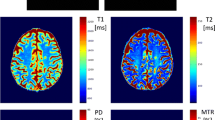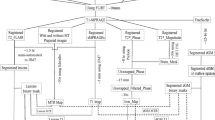Abstract
Previous studies have established the clinical relevance of hypointense lesions (“black holes”) on T1-weighted MRI as a surrogate marker for pathological change [36]. In contrast to measuring the volume of “black holes”, the direct measurement of T1 values allows an objective assessment of the changes contributing to hypointensity both in the focal lesions and in the normal appearing white matter (NAWM). The aims of this study were first, to determine the relationship between T1 values in the NAWM and in discrete lesions, second, to test the relationship between white matter T1 changes and measures of disability and third, to determine whether pathology leading to T1 change occurred in thalamic grey matter of patients with multiple sclerosis. 24 patients with clinically definite multiple sclerosis (13 with relapsing-remitting multiple sclerosis and 11 with secondary progressive multiple sclerosis) and 11 controls participated. White matter T1 histograms and mean T1 values for the thalamus were generated from whole brain T1 relaxation time maps measured using a novel echo-planar imaging based MRI sequence at 3Tesla. Tissue segmentation based on T2- and T1-weighted images allowed independent study of changes in lesions and NAWM. White matter T1 histograms from the patient group showed a reduced peak height and a shift towards higher T1 values (p = 0.028) relative to controls. The mean thalamic T1 was greater for secondary progressive patients than for healthy controls (p = 0.03). Mean white matter T1 values correlated significantly with disability (r = 0.48, p = 0.02). The mean T1 value in the T1-hypointense lesions correlated strongly with the mean T1 value in the NAWM (r = 0.80, p < 0.001). No significant relationship was found between mean white matter T1 value and cerebral volume (r = −0.23, p = 0.31). The T1 measurements extend previous observations suggesting that changes in the NAWM occur in parallel with pathology in lesions of MS. T1 measurements of either the total or NAWM therefore may provide a potentially observer- and scanner- independent marker of pathology relevant to disability in MS.
Similar content being viewed by others
Author information
Authors and Affiliations
Additional information
Received: 1 October 2001, Received in revised form: 7 January 2002, Accepted: 15 January 2002
Rights and permissions
About this article
Cite this article
Parry, A., Clare, S., Jenkinson, M. et al. White matter and lesion T1 relaxation times increase in parallel and correlate with disability in multiple sclerosis. J Neurol 249, 1279–1286 (2002). https://doi.org/10.1007/s00415-002-0837-7
Published:
Issue Date:
DOI: https://doi.org/10.1007/s00415-002-0837-7




